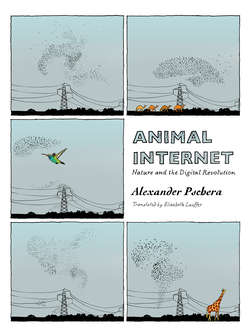Читать книгу Animal Internet - Alexander Pschera - Страница 16
На сайте Литреса книга снята с продажи.
ОглавлениеWHY WE KNOW WHETHER A SWALLOW IS FRIGHTENED IN A STORM
WHAT REALLY HAPPENS ON THE ANIMAL INTERNET
We currently know little more than one percent of the way animals live in the wild. That is to say, little more than nothing at all. We don’t know how little sea turtles behave just after they have slipped out of their eggs on the beach. We don’t know how a young cuckoo finds out where to go when autumn breaks. This is why it is also so hard to protect animals. Fundamental connections between the life of animals and their surroundings remain unknown. We know far too little about the lives of many endangered animals to help them effectively. We don’t even know if some species still exist. New species appear, or reappear, every year. Take, for instance, the Spotted-tail Quoll (Dasyurus maculatus), a carnivorous marsupial that was recently caught on remote digital camera in Australia’s Grampians National Park, after being presumed extinct for 141 years. The last of these animals was supposedly killed in 1872. They were considered a real pest then. The presence of this species, however, provides a wealth of information. It is a sign of a stable ecosystem, because, as a nocturnal carnivore, the Spotted-tail Quoll occupies a spot at the upper end of the food chain, therefore inviting comparison to the Tasmanian devil. If this animal has survived this long, then the same must be true of the species on which it preys. Generally speaking, however, humans’ prior knowledge of most animals is so minimal that it is impossible to deduce any further understanding from it. It does not provide any reliable empirical foundation upon which actionable strategies could be built. Every year, billions of birds and bats fly thousands of miles from their breeding grounds to their winter homes. What actually happens during these migrations, however, remains a mystery. What we know is that mortality rates are very high during migration. But what we don’t know is when and where highly mobile animals die. In many instances of endangered species, we cannot answer the question of what exactly we need to protect in order to save them: Is it food options? Water quality? Botanical diversity? What prevents us from creating a telling picture of nature and formulating effective rules for humans’ behavior toward it, is the lack of hard, empirical data and concrete information: What animals currently exist? How do they move around the planet? What do they do underground or at night? Whom do they eat, and who eats them?
The data gathered from the Animal Internet answer these questions. They produce a new image of nature. This image truly takes on form when considered within the context of a parallel development that began with the Information Age and continues to revolutionize our perspective on society. The concept we have of the structure of society has changed radically in the past ten years. The image of social strata and milieus, even of nationalities, used to be dictated by ideological default and assignation. The image associated with the working or middle classes used to align with the political theories that both engendered. “The Frenchman” or “the German” more or less represented national clichés. We primarily saw what we knew. We would then acknowledge representatives of these classes and nations and judge them accordingly. The ideologically fixed gaze first began softening with the introduction of new modes of direct communication and observation that established a new realism in perception. Telephone and television combined first with the Internet, then with social media, offering a visually supported opportunity for exchange and hypothetically providing any user with direct access to the unique lives of other users. The homogeneous, cut-and-dried preconceptions of class and nationality have increasingly fallen away as a result. Social media provides us with a picture of society as it truly is: full of contradictions, intersections, and dissonance. Today, those who want to hold tight to their ideological perspectives need to work a lot harder at it, and all too often, their efforts collapse when faced with the temptation to gain concrete impressions of the world. These new insights generate a dynamic that is also changing society. Because seeing creates knowledge, and knowledge leads to action. The social web is prepared to deconstruct social theories from the inside out, by starting an engine of social and systemic change free from ideological theorizing, as recent events in Egypt, Tunisia, Turkey and Ukraine have shown. Mobilizing the masses and coordinating social processes—these were the central functions of ideology. Social media has now taken on these duties. The Net has brought about a paradigm shift—out with theory and ideology, in with practice and reality.
